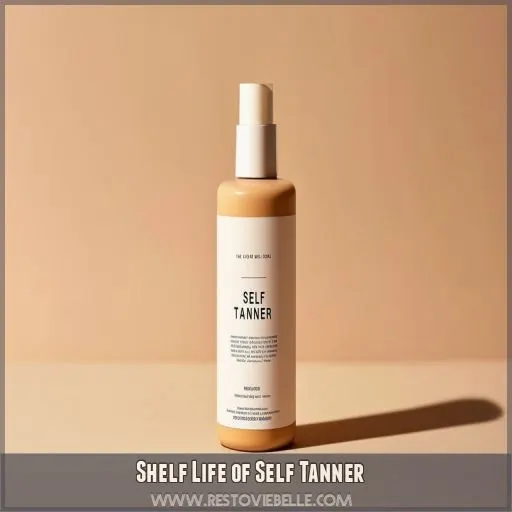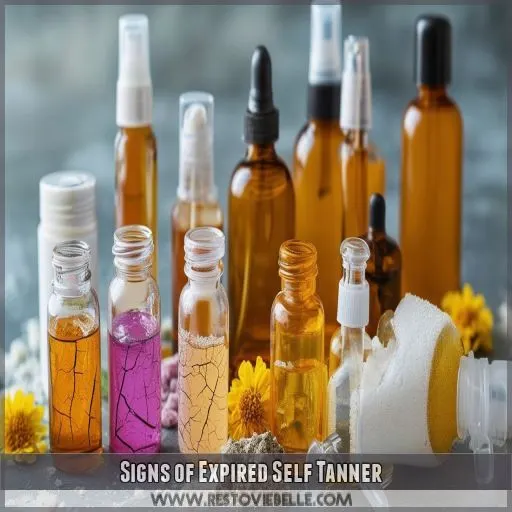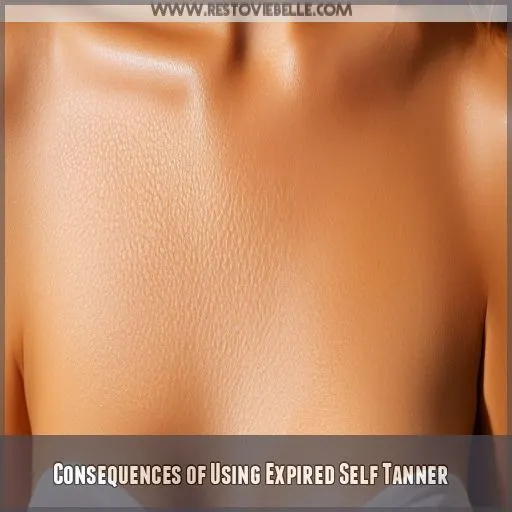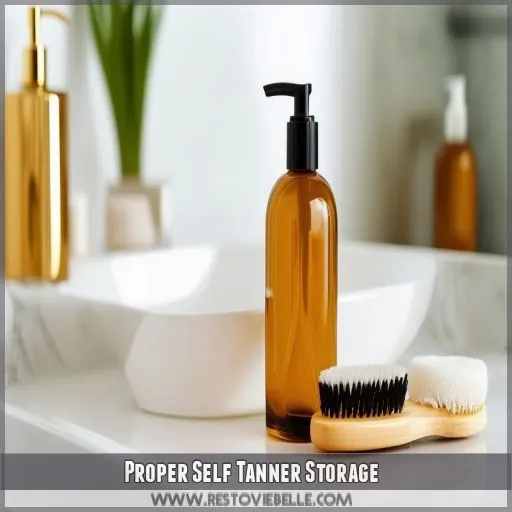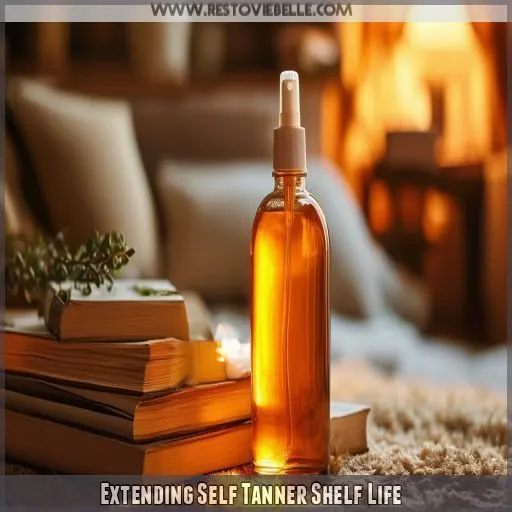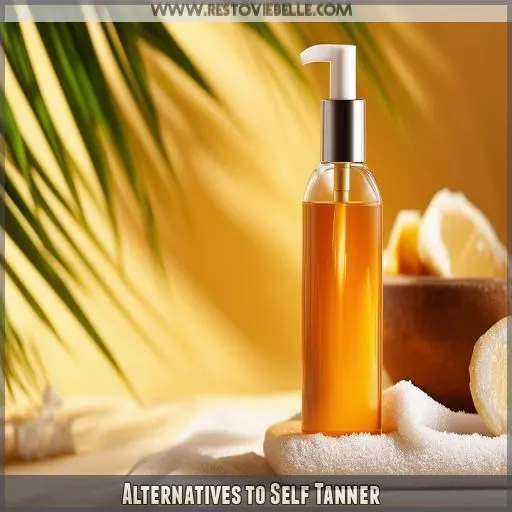This site is supported by our readers. We may earn a commission, at no cost to you, if you purchase through links.
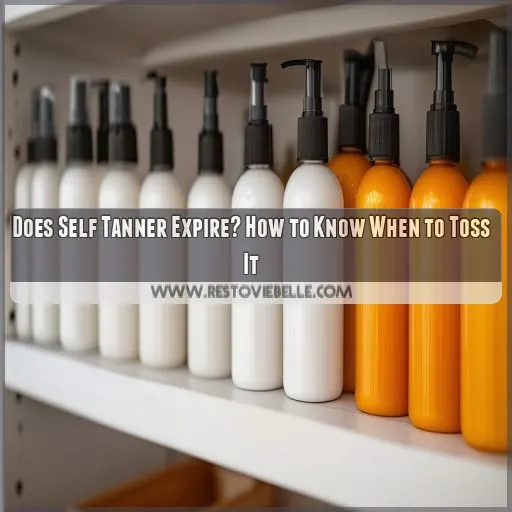
Self-tanners do not last forever. Using an expired product can lead to skin issues and an uneven tan.
In this article:
- Signs of expired self-tanner
- Proper storage methods
- Alternatives to contemplate
Table Of Contents
- Key Takeaways
- Does Self Tanner Expire?
- Shelf Life of Self Tanner
- Signs of Expired Self Tanner
- Consequences of Using Expired Self Tanner
- Proper Self Tanner Storage
- Extending Self Tanner Shelf Life
- Alternatives to Self Tanner
- Frequently Asked Questions (FAQs)
- How do you know if a fake tan is out of date?
- How long does self-tanner last?
- How long does it take for tanning lotion to expire?
- Can I still use my fake tan if it’s green?
- What are the ingredients in self-tanner?
- How does DHA breakdown impact self-tanner?
- What are the potential side effects of using expired self-tanner?
- How does self-tanner compare to other tanning methods?
- How often should you apply self-tanner?
- Conclusion
Key Takeaways
- Just like milk, self-tanner doesn’t last forever. Using an expired one could lead to skin irritation or an uneven tan.
- Prolong your self-tanner’s lifespan by storing it in a cool, dry place, away from direct sunlight.
- Be vigilant for any changes in color, texture, or smell. If you spot any, discard the self-tanner immediately. Expired products might harm your skin.
- Treat your self-tanner like a delicate food item; ensure you use clean tools and discard any remaining product after its expiration date. This prevents contamination and potential skin issues.
Does Self Tanner Expire?
Yes, self-tanner does expire. While it may not have the same severe consequences as expired sunscreen, using an expired self-tanner could lead to skin irritation or allergic reactions, especially if you have sensitive skin. It may also result in an uneven tan application or simply not work at all.
Even if your self-tanner is unopened, it will still expire. To make sure your self-tanner lasts as long as possible, store it in a cool, dry place, away from direct sunlight.
Shelf Life of Self Tanner
The shelf life of self-tanner varies depending on whether the product is unopened or already in use. As a general rule, self-tanners have a shelf life of:
- Unopened: 12-18 months
- Opened: 6-12 months
To maximize the shelf life of your self-tanner, pay attention to storage conditions. Keep the product in a cool, dark place, away from extreme temperatures and direct sunlight. Additionally, make sure the container is tightly closed to prevent contamination and maintain product efficacy.
Signs of Expired Self Tanner
You can identify expired self tanner by looking for signs like discoloration, separation, or an unpleasant odor. Consistency changes, reduced effectiveness, and skin irritation also indicate it’s time to toss it.
Discoloration or Separation
Discoloration or separation of ingredients is a clear sign that your self-tanner has expired. Changes in pigmentation or consistency indicate that the product’s shelf life has ended.
Changes in Consistency
Another tell-tale sign of expired self-tanner is changes in consistency. This can manifest in several ways, including:
- Formula separation: You might notice that the product has separated, with a watery layer on top or clumps of solid material.
- Texture differences: The texture may be clumpy or streaky, making it difficult to apply smoothly and evenly.
- Ineffective coverage: Expired self-tanner may not provide the desired sun-kissed glow, resulting in patchy or uneven coverage.
- Watery consistency: If the product has become too watery, it can be challenging to control the application and achieve the desired results.
Unpleasant Odor
If your self-tanner has an unpleasant odor, it’s likely expired. Expired self-tanners may cause unintended consequences, especially if you have sensitive skin. Here’s a table to help you identify potential issues:
| Odor Changes | Allergic Reactions | Skin Sensitivities |
|---|---|---|
| Unpleasant | Rash | Irritation |
| Off-Putting | Hives | Redness |
| Strange | No Visible Results | Itching |
To maintain product safety and avoid the worst-case scenario, always store your self-tanner at room temperature and keep an eye out for any odor changes.
Reduced Effectiveness
Apart from an unpleasant odor, you might notice your self-tanner isn’t as effective.
The color may not develop as deeply or last as long. You might need to apply more product to achieve your desired shade.
This reduced effectiveness indicates that active ingredients like DHA are breaking down and no longer work effectively.
Skin Irritation
Expired self-tanner can cause skin irritation, especially if you have sensitive skin. Keep an eye out for skin reactions like redness, itching, or rashes. If you’re prone to allergic reactions, do a patch test before use.
Consequences of Using Expired Self Tanner
Using expired self-tanner can lead to some undesirable outcomes, so it’s important to be aware of the potential consequences. Here’s what could happen if you use self-tanner that has gone past its prime:
- Uneven Tan: You might end up with a streaky or blotchy tan instead of a smooth, natural-looking glow. The product may not apply evenly, leaving you with an uneven tone that’s far from the flawless finish you desire.
- Skin Irritation: Expired self-tanner can cause redness, itching, or other forms of skin irritation. If you have sensitive skin, the risk of irritation is even higher, and you may experience allergic reactions like rashes or hives.
- Reduced Effectiveness: Over time, the active ingredients in self-tanner break down, leading to reduced effectiveness. This means you mightn’t achieve the desired level of tan, and the results may not last as long as they should.
Proper Self Tanner Storage
To maintain your self tanner’s efficacy, store it in a cool, dry place away from sunlight, and always keep it upright. Avoid humid environments by placing it in a drawer or cabinet to extend its shelf life.
Cool and Dry Storage
Cool and dry storage is key to preserving your self-tanner’s shelf life. Avoid exposing the product to extreme temperatures and humidity, as these can impact its consistency and effectiveness. Always store it in a drawer or cabinet, away from direct sunlight.
Shielding From Sunlight
Protecting your self-tanner from sunlight is essential for preserving its quality and effectiveness. Sunlight exposure can cause damage and hinder the product’s performance. Store your self-tanner in a cool, dry place, away from direct sunlight, to guarantee its stability and provide maximum skin protection.
Upright Storage
When storing your self-tanner, it’s important to keep it upright. This simple step helps maintain the product’s shelf stability and longevity. Here are some key reasons why:
- Preservation Methods: Upright storage guarantees the self-tanner’s ingredients remain evenly distributed, preventing separation and clumping.
- Air Exposure: Minimizing air exposure within the bottle helps maintain the product’s freshness and consistency.
- Temperature Control: Keeping the self-tanner upright helps regulate temperature, as the product isn’t in direct contact with the bottle’s surface, reducing the risk of overheating.
- Product Placement: Storing the product upright makes it easier to identify and access, reducing the chances of accidental spills or leaks.
- Convenience: Upright storage allows for efficient use of space, making it convenient to store multiple bottles or products of different sizes.
Avoiding Humid Environments
Keep your self-tanner away from humid environments, as humidity can impact its shelf life and effectiveness. Store it in a cool, dry place, like a bathroom cabinet or bedroom drawer, to keep it in excellent condition.
Drawer or Cabinet Storage
Storing your self-tanner in a drawer or cabinet is an effective way to maintain shelf stability and create extra storage solutions. Here are some tips for effective drawer or cabinet storage:
- Designate a specific drawer or cabinet for your self-tanning products, ensuring it’s cool, dry, and shielded from sunlight.
- Organize the products neatly, perhaps in a small basket or tray, to avoid clutter and make retrieval easy.
- Keep the storage area well-ventilated to prevent humidity and promote product longevity.
- Regularly clean the drawer or cabinet to maintain optimal hygiene for your self-tanning routine.
Extending Self Tanner Shelf Life
To extend the shelf life of your self tanner, store it in a cool, dark place, and avoid contaminating it by using clean tools each time. Remember to discard any unused product after its expiration date to prevent skin irritation or ineffective application.
Storage Conditions
To extend your self-tanner’s shelf life, store it in a cool, dry place, away from sunlight, and upright.
Avoid humid environments and opt for a drawer or cabinet.
These conditions will help maintain product consistency and prevent issues like clumping or streaking.
Avoiding Contamination
Another way to extend the shelf life of your sunless tanning products is to prevent contamination. Always keep the container tightly closed when not in use, and use clean tools for application to avoid introducing bacteria or other contaminants. Be sure to use the product within the recommended timeframe, as even proper storage can’t prevent expiration indefinitely.
Discarding Unused Product
To extend the shelf life of your self-tanner, always follow the storage instructions on the product label. When it’s time to discard it, be mindful of disposal methods and their environmental impact. Check with your local waste management company for recycling options, as some beauty product containers can be recycled.
Alternatives to Self Tanner
If you’re not a fan of self-tanners, there are plenty of other options to get that sun-kissed glow. Here are some alternatives to examine:
- Spray tans: This option gives you a quick, even tan without the need for lotions or creams. It’s a great choice if you want a natural-looking tan without the hassle of applying self-tanner.
- Tanning beds: Tanning beds use UV light to give you a tan. While they can provide a deeper, longer-lasting tan than self-tanners, it’s important to remember that UV exposure comes with risks, including skin cancer and premature aging.
- Sunless tanning lotions: These lotions gradually build a tan over time, giving you more control over the depth of color. They’re a good option if you want a low-maintenance way to achieve a natural-looking tan.
In addition to these alternatives, you can also explore bronzing powders for a temporary glow or gradual self-tanners that build color over time. Remember to always patch test any new product and choose options suitable for your skin type to avoid irritation.
Frequently Asked Questions (FAQs)
How do you know if a fake tan is out of date?
Your fake tan will have a natural sell-by date, after which there’s a risk it’ll turn green. You can also look out for signs like black chunks of debris, mold, or a strange odor. Keep an eye out for streaks and discoloration too.
How long does self-tanner last?
Self-tanner can last anywhere from 4 to 10 days, depending on skin type, skin care, and the type of self-tanner used. Oily skin types may see results for 5 to 6 days, while dry skin types may only see results for 1 to 2 days.
How long does it take for tanning lotion to expire?
Tanning lotions have a shelf life of around 12 months, but can last up to 18 months unopened. After this, they become ineffective, although they’re mostly non-toxic.
Can I still use my fake tan if it’s green?
A green fake tan is a sign that it’s expired or hasn’t been stored properly. Although it will wash off and won’t affect the final colour, it’s best not to apply it. If you do, wash it off immediately.
What are the ingredients in self-tanner?
Self-tanners typically contain Dihydroxyacetone (DHA) as their active ingredient, but there are dozens of other ingredients, including erythrulose, skin conditioners, oils, and encapsulation technology.
How does DHA breakdown impact self-tanner?
DHA breakdown impacts the intensity and depth of your tan. DHA is limited to a maximum of 10% in the EU. It only reacts with the top layer of your skin, so it doesn’t damage DNA.
What are the potential side effects of using expired self-tanner?
You could experience skin irritation, rashes, and even infections from bacterial growth. Expired self-tanner may also cause sunburns due to reduced SPF protection.
How does self-tanner compare to other tanning methods?
Self-tanning methods include sprays, mousses, lotions, waters, and drops. Compared to UV tanning, self-tanning is safer as it doesn’t involve the sun’s rays or tanning beds, which can age your skin.
How often should you apply self-tanner?
Self-tanner application varies from person to person. While some recommend applying it every three to four days, others suggest a weekly application. The key to maintaining your tan is moisturising daily and exfoliating gently every other day.
Conclusion
Knowing when to discard your self-tanner is imperative for maintaining a flawless artificial glow.
Self-tanners do expire, and using them past their prime can lead to skin troubles and a patchy tan.
[Keypoints]Signs of expiration include:
- Discoloration
- Changes in texture
- Unpleasant smells
- Reduced performance
- Skin irritation
Proper storage, such as keeping the product in a cool, dry place away from sunlight, can prolong its life, but even then, self-tanners won’t last forever.
Be vigilant for expiration signs and discard the product if unsure, to avoid any potential skin issues.

